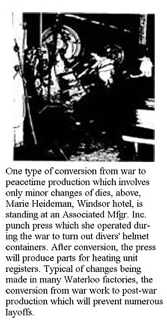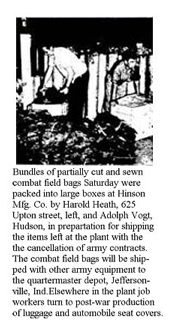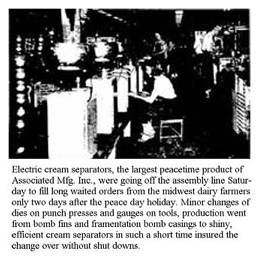Source: Waterloo Dailey Courier, Waterloo, Iowa, Sunday, August 19, 1945
REVEAL STORY OF WATERLOO WAR EFFORT
PRODUCTS TO ALL BRANCHES OF U.S. FORCES
Full Details of Industrial Aid to Fighting Men
Told for First Time.
By Kathleen Smith
Courier Staff Writer.


NOW IT CAN BE TOLD –
This story of Waterloo’s four-year home front battle of production which furnished to our fighting men and women billions of supplies.
To them we have sent millions of pounds of meat, thousands of tons of clothing and outdoor housing units, millions of dollars worth of munition parts, and billions of small and large vehicle parts.
Napoleon said, “An army travels on its stomach.” And the United States has seen to it that the men fighting all over the world have plenty of meat and other foods.
Fifth of Nation’s Meat.
The Rath Packing Co., only one of a number of major meat packing firms throughout the nation, has filled army, navy and lend lease contracts totaling $100,000,000, according to Howard H. Rath, vice-president.
And for those who like to think in huge totals, multiply the Rath total by just five to get a conservative estimate of the amount of meat eaten by service men and women in this country and the peoples of our Allied countries.
The ending of World War II will make little difference in the preparation and processing of meat at Rath’s. Some new methods have been discovered during the past four years, and all will probably be used in civilian meat packing.
“People always eat meat – war or peace,” an official of the plant reported.
And that is the reason why Rath Packing Co. will continue production “as usual” now and in the later postwar years.
Army Travel.
An army really doesn’t travel on its stomach – it travels by truck, tank, jeep and airplane, and the John Deere Tractor Co. did its wartime share by making over $130,000,000 worth of tank transmissions and airplane parts. L. A. Rowland, general manager of all Deere tractor production reported.
During the last few months of the war, that plant was converting to its peacetime production of tractors, and by Saturday they were rolling off the assembly line for delivery to the farmers who have patched and coaxed, babied and bullied their worn out machines to make them last out the war.
Observers say the farsightedness of men directing the Deere company toward reconversion has carried that firm over to the present sudden stoppage into continued production without shut-downs or layoffs.
Fighting Arms.
A well-fed soldier driving his tank over enemy terrain has to have something with a loud and destructive force to back up the cause for which he is fighting. He has to have bombs.
Several Waterloo war plants have devoted all or part of their production to bombs.
Starting on its war production in 1941, before the start of the war, Chamberlain, Corp. since that time has manufactured the three-inch monoblock shot, three-inch armor piercing shot, 90-mm armor piercing shot, four and a half inch rocket, 100 pound general purpose bomb, 115 pound gas bomb, 220 pound fragmentation bomb and the 260 pound fragmentation bomb.
At peak production the corporation was sending our soldiers 110 carloads of bombs per month.
N. L. Etten, vice-president and general manager of the corporation estimated the total war contracts for that firm at more than $35,000,000.
Large Ordnance Contract.
During the latter part of the war program for Chamberlain’s they were using six million pounds of steel per month and held the largest ordnance contract in the quad-city ordnance district, which included part of Wisconsin, Illinois, Minnesota and all of Iowa.
A total of 1,700 people were on the payroll receiving well over $100,000 per week, Etten reported, and the company was 100 per cent in war work.
Although enemies of this country have cried “quits” Chamberlain Corp. still has contracts on a number of confidential items to be continued and completed.
Also manufactured at the Chamberlain Corp. during the war were a few seat liners which went into bombs from 90 to 2,000 pounds in weight; 10-man rubber landing boats, and 50-caliber gun mount parts.
Bomb Development.
Part of the story from Chamberlain’s [Page 17] which couldn’t be told until the enemy laid down his arms concerns the achievements of the engineering department in bomb development, according to Etten.
The plant’s engineering department developed a new method of manufacturing large fragmentation bombs which not only reduced the cost to the government, but in addition, produced bombs approximately 20 per cent more effective for given size and shape, Etten said.
“This development,” said Etten, “was estimated by army authorities to have saved the government $15,000,000 on the fragment bomb program.”
Processes used in this bomb were patented by the Chamberlain Corp. but the company assigned them without charge to the government as part of its contribution to the war effort.
Produced Elsewhere.
Six other fragment bomb producers located in other parts of the country were assisted in setting up their production program by engineers from the Waterloo plant and these manufacturers had exact copies of the Waterloo plant.
Chamberlain Corp. is proud of the “now it can be told” fact that it was the largest producer of fragmentation bombs in the entire country.

For 40 months, Associated Manufacturers, Inc. produced bomb parts and over a million fragmentation bombs. The firm’s total war contracts reached $6,500,000, and official there said Saturday. In addition they made navy cabinet parts, divers’ helmet boxes, and black-out wings and frames for windows.
Quick Change.
But Saturday morning there were only a few reminders let to show the output of tremendous numbers of these supplies. The assembly line was working full force turning out the firm’s own cream separator. Dies on small parts machines had been changed over.
And the same machines which last Monday were making bomb fins and casings Saturday were making separator motor casings.
Approximately $2,000,000 worth of small tank parts were manufactured by the Litchfield Co. during the war years, and at Hawkeye Steel Products Co. 100,000 castings were completed since May 1, 1945.
Litchfield Co. has returned to its regular line of farm wagons, manure spreaders, and other farm implements, and Hawkeye Steel continues its machining of castings for many uses.
Army, Navy Clothing.
The soldier, whether in the far cold north or the humid sultry south, has had to have clothing and shelter, and containers for his personal belongings and the shells he used in his gun.
Waterloo textile plants fulfilled their part in furnishing these required articles of equipment.
For nearly three years Hinson Manufacturing Co. has cut, sewed and sent to the army and navy an average of two freight cars of equipment every week, James H. Hinson, vice-president, estimates.
1,250 Tons.
A conservative estimate sets the shipment from that plant at 1,250 tons. This equipment included combat field bags, cartridge belts, ruck sacks, gun covers, jungle packs, parachute packs for the army and sea bags and luggage bags for the navy.
When the war came to an abrupt close last Tuesday the army contracts were cancelled, but work is continuing on the navy goods, officials of the plant report.
But Saturday morning the peacetime products of the company were in evidence again as stacks of seat covers and traveling bags began to grow in all corners of the large sewing room.
Unfinished Products.
While the workers on civilian goods were busy catching up with the piles of orders in the front office, in the back of the plant a few men were filling and nailing the big boxes of unfinished army articles in preparation for shipping to the quartermaster depot at Jeffersonville, Ind.
Stacked in this warehouse-like room are rows and rows of boxes, every one containing articles in all stages of unfinish. One employe (sic) pointed out that a ‘small’ part of his work was the packing of 35,000 incomplete field bags.
The other local plants have been producing articles of wearing apparel.
Flying Boots.
Rankin Manufacturing co. has sent 150,000 fleece-lined flying boots for the army air forces, and Powers Manufacturing co. has made 125,000 packets, 20,000 army shirts, and 5,000 sets of basketball suits for the quartermaster corps of the army.
Flying boots were not the only items making up the $6,000,000 worth of contracts at Rankin’s. Workers there used over five million yards of cloth to make the army equipment.
Their orders included 7,900 tents, 16x33 feet; 42,000 large tarpaulins; 16,000 tow targets, and the 150,000 flying boots. And to make this huge amount of heavy canvas equipment, 225 persons were employed, information from Lee Oberle, general manager, disclosed.
Sport Clothes.
Operators of machines at Powers Manufacturing Co. are still working on the order for 5,000 sets of basketball suits, and, according to an official there, such contracts will continue with the quartermaster corps, L. J. Powers, president, reported.
An American soldier will play basketball in his free hours, and tournaments are being held in all theaters of operations. Whether the basketball court is in a bombed-over city lot or a German city’s stadium, the players will have regulation suits.
NOW IT CAN BE TOLD!
Source: Waterloo Dailey Courier, Waterloo, Iowa, Sunday, August 19, 1945, Section Two, Pages 15 & 17 (photos included)
